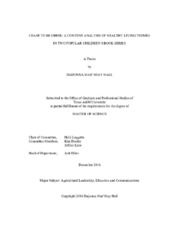| dc.contributor.advisor | Leggette, Holli R | |
| dc.creator | Hall, Daijonna Mar'Shay | |
| dc.date.accessioned | 2017-02-02T15:39:41Z | |
| dc.date.available | 2018-12-01T07:20:51Z | |
| dc.date.created | 2016-12 | |
| dc.date.issued | 2016-12-06 | |
| dc.date.submitted | December 2016 | |
| dc.identifier.uri | https://hdl.handle.net/1969.1/158642 | |
| dc.description.abstract | Childhood obesity has been a prevalent issue over the decades, that can occur as a result of genetic and non-genetic factors. Because of advancements in technology over the years, many Americans have strayed away from living traditional lifestyles that embed a healthy diet and physical activity into their everyday lives.
In the past, a few studies have examined the effect books have on preschool aged children’s behavior toward healthy food because it is at this age children begin to develop attitudes toward food. However, these studies only focused on the frequency of healthy food depictions and messages in books provided by reading lists, libraries, physician’s offices, and best seller list to name a few.
This study focuses on healthy food as well as the depictions and messages in preschool children’s books encouraging healthy living. Additionally this study compares two book series tied to popular television shows, one contemporary and one longstanding.
The findings revealed that although each series incorporated sub-themes regarding healthy living into the text and illustrations, the frequency of these sub-themes were heavily outweighed by other sub-themes not concerning healthy living. Furthermore, verbal and imagery codes for healthy living sub-themes were not combined as often as anticipated. Additionally, the long-standing series was revealed to be the more health conscious series of the two because of the large amount of background depictions of healthy food.
I concluded that the deficit in sub-themes concerning healthy living exists because neither series purpose was to educate children on health education. This conclusion also explains why there were not as many combinations of verbal and imagery codes regarding healthy living as anticipated.
From the literature it is apparent any type of media can have an effect on children’s behavior. However, to better understand how books affect children’s behavior toward healthy living, more research involving children must be done. The findings of the study also revealed that there is a lot more work to be done by agricultural communicators to decrease and hopefully end childhood obesity. | en |
| dc.format.mimetype | application/pdf | |
| dc.language.iso | en | |
| dc.subject | childhood obesity | en |
| dc.subject | obese | en |
| dc.subject | children's books | en |
| dc.subject | health | en |
| dc.subject | healthy living | en |
| dc.title | Cease to be Obese: A Content Analysis of Healthy Living in Two Popular Children's Book Series | en |
| dc.type | Thesis | en |
| thesis.degree.department | Agricultural Leadership, Education, and Communications | en |
| thesis.degree.discipline | Agricultural Leadership, Education, and Communications | en |
| thesis.degree.grantor | Texas A & M University | en |
| thesis.degree.name | Master of Science | en |
| thesis.degree.level | Masters | en |
| dc.contributor.committeeMember | Dooley, Kim Walters | |
| dc.contributor.committeeMember | Liew, Jeffrey | |
| dc.type.material | text | en |
| dc.date.updated | 2017-02-02T15:39:41Z | |
| local.embargo.terms | 2018-12-01 | |
| local.etdauthor.orcid | 0000-0003-4440-2258 | |


